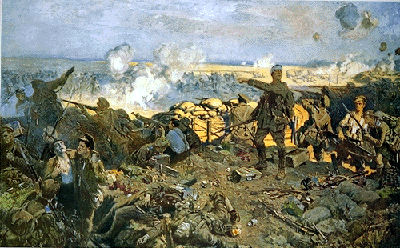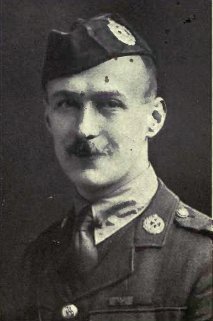Frederick William Hall, VC, soldier, musician, clerk (born 21 February 1885 in Kilkenny, Ireland; died 24 April 1915 near Ypres, Belgium). During the First World War, Sergeant-Major Fred Hall was the first of three soldiers, all from the same street in Winnipeg, to be awarded the Victoria Cross (VC), the highest award for bravery among troops of the British Empire. The three VCs earned by the men of Pine Street — later named Valour Road — was a feat unmatched in any other part of the Empire.

Early Life
Fred Hall grew up in an Irish family with seven children. An excellent student, he apprenticed as a lawyer until choosing instead to join the well-known Scottish Rifles regiment as a career soldier. Coming from a talented musical and military family, Hall played the trombone during his 12-year military career in Britain and India.
After his father’s death, he joined his mother, Mary, and three of the family’s younger children in moving to Canada in August of 1913 to find a new life. The family settled in Winnipeg, where Hall secured a job as a shipping clerk and found lodgings at 772 Pine Street. Hall also joined Winnipeg’s kilted militia regiment, the 79th Cameron Highlanders, playing trombone in the militia band.
War Experience
As a relative newcomer to the 79th Highlanders, Hall was unable to sign up with the regiment when war was declared by the British Empire on 4 August 1914. Many enthusiastic militia soldiers had enlisted as soon as the call went out. Three days later, Hall joined a new unit, the 106th Light Infantry, and soon transferred to the 8th Battalion — largely formed from the famous 90th Winnipeg Rifles (nicknamed the Little Black Devils as a result of their successes in the North-West Rebellion of 1885).
With his youngest brother, Harry, Hall trained at Valcartier Camp in Quebec. In October, he and Harry shipped out to England to drill at Canada’s muddy training camp on Salisbury Plain. The brothers arrived in France in February 1915 with the 1st Division of the Canadian Expeditionary Force. Given his experience in the British Army, Hall was promoted to company sergeant-major, in charge of more than 220 men. On 14 April 1915, Hall’s 8th Battalion moved into the Ypres salient of the Allied trenches of the Western Front.
Bravery at Gravenstafel Ridge
The 8th Battalion took its place at the front line during the Second Battle of Ypres on 17 April 1915, and within days would be repeatedly battered by German artillery. On 22 April, the Germans released a cloud of poisonous chlorine gas against the Allied troops. Hall’s battalion was among those who turned to their makeshift respirators to survive. Casualties for the battalion mounted rapidly in the desperate fighting, as Canadians in the salient fought to avoid encirclement by the Germans.

On 24 April, Lieutenant Colonel Louis Lipsett, commander of the 8th Battalion, ordered the battalion’s reserve company to seal the dangerously exposed right flank of the Canadian line. After the transfer, Hall, aged 30, made two trips out of his trench to rescue injured men stranded in no-man's land, and came back with a wounded soldier each time.
Later, Hall again heard the cries of a wounded man trapped in no-man’s land off Gravenstafel Ridge, weakly calling for help as shells continued to burst around him. Hall attempted a rescue with two other soldiers, but when these men were also wounded, they were forced to retreat. Hall was determined to try again, this time alone. He climbed out of his trench and crawled 15 metres to Private Arthur Clarkson, who lay dying beneath the slope of a bank. As he tried to lift Clarkson, Hall was shot directly in the forehead. Both men died — Hall immediately and Clarkson soon afterwards.
The battle continued around them, but on 25 April the 1st Canadian Division held firm against the German attack. When the savage defensive battle ended, the Canadians had suffered more than 6,000 casualties.
Victoria Cross
When Mary Hall learned that her son Fred had died while rescuing another man, she said, “That was just like him. He never thought of himself. He did not fear anything.” Hall was nominated posthumously for the Victoria Cross for gallantry in action. British military tradition especially honours selfless acts of devotion among soldiers. The medal — a bronze cross inscribed with the words "For Valour" — was presented a few months later to Hall’s mother in Winnipeg, one year after her son had first boarded the train bound for Valcartier.

Hall was the first of three men from Pine Street to receive the Victoria Cross. Later in the war, Corporal Leo Clarke and Lieutenant Robert Shankland would also become "Valour Road" heroes. The Canadian War Museum proudly holds the Victoria Crosses earned by each of the three.
Hall's remains were never identified. He is commemorated on the Menin Gate Memorial in Ypres, Belgium, and on a plaque on Valour Road in Winnipeg. The heroism of Hall, Clarke and Shankland is featured in “Valour Road,” a Heritage Minute released in 1991. Canada Post issued a stamp honouring the three men in October 2021.
(See also The Canadian Great War Soldier and Evolution of Canada's Shock Troops.)

 Share on Facebook
Share on Facebook Share on X
Share on X Share by Email
Share by Email Share on Google Classroom
Share on Google Classroom


